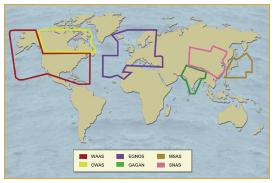If you wish to contribute or participate in the discussions about articles you are invited to contact the Editor
SBAS Interoperability: Difference between revisions
Jon.Caudepon (talk | contribs) No edit summary |
Jon.Caudepon (talk | contribs) |
||
| Line 18: | Line 18: | ||
==Other SBAS Systems== | ==Other SBAS Systems== | ||
[[File:SBAS_Interoperability2.JPG| SBAS Interoperability |300px|thumb|right]] | |||
In the mid-1990s, three regions took up the gauntlet to develop SBAS systems: Europe, the US, and Japan.<ref name=" SBAS Interoperability">[http://www.egnos-pro.esa.int/Publications/2005%20Updated%20Fact%20Sheets/fact_sheet_14.pdf SBAS - ITEROPERABILITY EXPLAINED - DELIVERING A GLOBAL SERVICE] </ref> | In the mid-1990s, three regions took up the gauntlet to develop SBAS systems: Europe, the US, and Japan.<ref name=" SBAS Interoperability">[http://www.egnos-pro.esa.int/Publications/2005%20Updated%20Fact%20Sheets/fact_sheet_14.pdf SBAS - ITEROPERABILITY EXPLAINED - DELIVERING A GLOBAL SERVICE] </ref> | ||
| Line 26: | Line 28: | ||
Japan is developing an SBAS founded on its Multi-function Transport Satellite (MTSAT) called the MTSAT Satellite Augmentation System or MSAS. The first phase based on single geostationary satellite coverage is planned for 2005 while the second phase based on dual geostationary satellite coverage is planned for 2006. We expect MSAS to deliver a Non Precision Approach capability, and this could be enhanced to provide precision approach performances (e.g. APV-1). | Japan is developing an SBAS founded on its Multi-function Transport Satellite (MTSAT) called the MTSAT Satellite Augmentation System or MSAS. The first phase based on single geostationary satellite coverage is planned for 2005 while the second phase based on dual geostationary satellite coverage is planned for 2006. We expect MSAS to deliver a Non Precision Approach capability, and this could be enhanced to provide precision approach performances (e.g. APV-1). | ||
Other regions, such as Japan, provide its own SBAS system, named MSAS (MTSAT-based satellite augmentation system). | Other regions, such as Japan, provide its own SBAS system, named MSAS (MTSAT-based satellite augmentation system). | ||
==Notes== | ==Notes== | ||
Revision as of 17:13, 9 May 2011
| EGNOS | |
|---|---|
| Title | SBAS Interoperability |
| Author(s) | GMV. |
| Level | Basic |
| Year of Publication | 2011 |
In addition to EGNOS, there are other Satellite Based Augmentation Systems (SBAS) under development: the wide area augmentation system (WAAS) in USA, the multi-functional transport satellite (MTSAT) satellite-based augmentation system (MSAS), in Japan, the GAGAN system in India and the SNAS system in China. Although all SBAS are currently defined as regional systems, it is commonly recognized the need to establish adequate co-operation/co-ordination among the different systems, so that their implementation becomes more effective and part of a seamless world-wide navigation system.[1]
To guarantee seamless and worldwide system provision, it is essential that the existing systems do meet some common interoperability requirements and do provide adequate system. The service providers of the EGNOS, WAAS and MSAS systems are regularly meeting through so called “interoperability working group (IWG)” meetings to conclude on a the precise understanding of the term interoperability, and on the identification of the necessary interfaces among SBAS that each conceivable interoperability scenarios may imply. The EGNOS system achieved.
In addition to interoperability, EGNOS has built-in expansion capability to enable extension of the services over regions within the Geostationary Broadcast Area of GEO satellites used, such as Africa, Eastern countries, and Russia.
The combination of SBAS Interoperability and expansion concepts should allow providing a true global world-wide navigation seamless service.
Other SBAS Systems
In the mid-1990s, three regions took up the gauntlet to develop SBAS systems: Europe, the US, and Japan.[2]
In the United States of America, the Federal Aviation Administration has taken the lead for developing its Wide Area Augmentation System or WAAS. The WAAS signal was made available for non-aviation users in 2000. It currently delivers accuracies of one meter horizontal and two meters vertical and supports aviation precision approach (APV-1) performance. An Initial Operational Capability (IOC) for aviation use started in July 2003 and its Full Operational Capability (FOC) is planned for the end of 2007.
Japan is developing an SBAS founded on its Multi-function Transport Satellite (MTSAT) called the MTSAT Satellite Augmentation System or MSAS. The first phase based on single geostationary satellite coverage is planned for 2005 while the second phase based on dual geostationary satellite coverage is planned for 2006. We expect MSAS to deliver a Non Precision Approach capability, and this could be enhanced to provide precision approach performances (e.g. APV-1).
Other regions, such as Japan, provide its own SBAS system, named MSAS (MTSAT-based satellite augmentation system).
Notes
References
- ^ The European EGNOS Project: Mission, Program and System Description; J.Ventura-Traveset, L. Gauthier, F. Toran and P.Michel, ESA EGNOS Project office, European Space Agency (ESA); G. Solari and F. Salabert, Galileo Joint Undertaking (GJU); D. Flament, J. Auroy and D. Beaugnon, Alcatel Alenia Space
- ^ SBAS - ITEROPERABILITY EXPLAINED - DELIVERING A GLOBAL SERVICE

